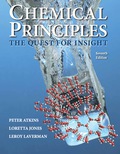
(a)
Interpretation:
The amount of energy released has to be given.
Concept Introduction:
Nuclear binding energy and the mass defect:
Nuclear binding energy is the minimum energy that would be required to disassemble the nucleus of an atom into its component parts. These component parts are neutrons and protons which are collectively called nucleons. The mass of an atomic nucleus is less than the sum of the individual masses of the free constituent protons and neutrons according to Einstein’s equation
(a)
Answer to Problem 10C.5E
The total amount energy released is
Explanation of Solution
Given:
The mass of neutron is
The mass of Deuterium is
The mass of the Helium-3 is
The mass defect can be calculated as,
Mass of the reactants =
Mass of the products =
The change in energy (
(
(
The number of atoms in the sample is,
The total amount of energy released is,
The total amount energy released is
(b)
Interpretation:
The amount of energy released has to be given.
Concept Introduction:
Refer to part (a).
(b)
Answer to Problem 10C.5E
The total amount energy released is
Explanation of Solution
Given:
The mass of Hydrogen-1 is
The mass of Deuterium is
The mass of the Helium-3 is
The mass of Helium-4 is
The mass defect can be calculated as,
The change in energy (
(
(
The number of atoms in the sample is,
The total amount of energy released is,
The total amount energy released is
(c)
Interpretation:
The amount of energy released has to be given.
Concept Introduction:
Refer to part (a).
(c)
Answer to Problem 10C.5E
The total amount energy released is
Explanation of Solution
Given:
The mass of Hydrogen-1 is
The mass of Lithium is
The mass of Helium-4 is
The mass defect can be calculated as,
The change in energy (
(
(
The number of atoms in the sample is,
The total amount of energy released is,
The total amount energy released is
(d)
Interpretation:
The total amount of energy released has to be given.
Concept Introduction:
Refer to part (a).
(d)
Answer to Problem 10C.5E
The total amount energy released is
Explanation of Solution
Given:
The mass of neutron is
The mass of Deuterium is
The mass of Helium-4 is
The mass of tritium is
The mass defect can be calculated as,
The change in energy (
(
(
The number of atoms in the sample is,
The total amount of energy released is,
The total amount energy released is
Want to see more full solutions like this?
Chapter 10 Solutions
EBK CHEMICAL PRINCIPLES
 Chemistry: Principles and ReactionsChemistryISBN:9781305079373Author:William L. Masterton, Cecile N. HurleyPublisher:Cengage Learning
Chemistry: Principles and ReactionsChemistryISBN:9781305079373Author:William L. Masterton, Cecile N. HurleyPublisher:Cengage Learning Chemistry: The Molecular ScienceChemistryISBN:9781285199047Author:John W. Moore, Conrad L. StanitskiPublisher:Cengage Learning
Chemistry: The Molecular ScienceChemistryISBN:9781285199047Author:John W. Moore, Conrad L. StanitskiPublisher:Cengage Learning- Chemistry: Matter and ChangeChemistryISBN:9780078746376Author:Dinah Zike, Laurel Dingrando, Nicholas Hainen, Cheryl WistromPublisher:Glencoe/McGraw-Hill School Pub Co
 Chemistry & Chemical ReactivityChemistryISBN:9781337399074Author:John C. Kotz, Paul M. Treichel, John Townsend, David TreichelPublisher:Cengage Learning
Chemistry & Chemical ReactivityChemistryISBN:9781337399074Author:John C. Kotz, Paul M. Treichel, John Townsend, David TreichelPublisher:Cengage Learning Chemistry & Chemical ReactivityChemistryISBN:9781133949640Author:John C. Kotz, Paul M. Treichel, John Townsend, David TreichelPublisher:Cengage Learning
Chemistry & Chemical ReactivityChemistryISBN:9781133949640Author:John C. Kotz, Paul M. Treichel, John Townsend, David TreichelPublisher:Cengage Learning





